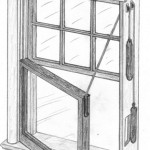Window Repair

If you have ever lived in an older home, chances are you have had a window or two that wouldn’t stay open without the help of a stick or a book. As a leading home inspection company in Buffalo and all of Western New York, we have seen our share of older housing stock and with it, windows that don’t work.
Well, the fix might be easier than you thought. You see, these older windows stay open with the use of counterweights. Counterweights are usually cast iron cylinders found inside the wall cavity, next to the window frame.
Their purpose is to maintain the position of the window once it is operated. They also assist in lifting and closing the window by accepting some of the weight of the sash.
It is not uncommon to find broken ropes or cords that secure the counterweight to the window sash.
Even if there is no evidence of a cord, don’t be surprised if the counterweight is still in the wall cavity.
You can generally judge if your window had a counterweight if there is a pulley at the top of the window frame, inside the track where the sash slides.
To fix a broken cord, follow these steps:
- Assuming a counterweight system was used; remove the stop mouldings on the side of the window sash.
- Once removed, remove or raise the window. If you raise it, secure it properly so it does not fall out.
- With the mouldings and window sash out of the way, look at the bottom of the track where the window slides. There should be a cut out on both sides, most likely secured with a screw.
- Remove the screw and access to the counterweight is now available.
- Before you pull the counterweight out, tie a new piece of cord, clothesline rope will work fine, to the end of the old cord (the end that would be attached to the window sash). Yank it out and you will add about an hour to each window just by trying to fish the new cord through.
- With the new cord fed through and the counterweight removed, tie the end of the cord to the counterweight, I would also recommend crimping a piece of metal to the cord and its end as an added measure of securing the cord. The counterweights can be heavy and continued use over time may cause the knot to loose, crimping a metal clasp to the knot will reduce this risk.
- Feed the counterweight back into the cavity.
- Pull the rope tight but do not lift the counterweight. It is at this point the counterweight will no longer work, therefore it will also be the very highest point to which you can raise the window.
- By now the window sash is probably not in place, I would suspect it has since been removed.
- You will notice a track with a larger opening on each side of the window sash to accommodate the cord and its knot. Put the window back into place.
- Determine the highest point to which you would like the window to open.
- Determine the corresponding length of cord to use on each side. Knot the end and crimp with a metal clasp.
- Insert the cord and knot in the track. Place the window into position and test.
- Replace access pieces to the counterweights and stop mouldings.
It is not uncommon for the pulleys at the top of the window sash track to become gunked up with paint thereby preventing operation. All the new counterweight cords in the world won’t make a bit of difference if the pulley does not function freely. They can be reconditioned fairly easily.
- With the window closed or removed, access is provided to the pulley.
- Most pulleys are installed so they can be removed without dismantling the entire window system.
- If there are several coats of paint on the window, look carefully and you should find a screw just above and just below the pulley.
- Scored the paint as much as possible and remove the screws.
- The pulley is now free of mechanical devices to allow for removal. Just be sure to try and clean away as much paint as possible to completely free the pulley from its opening.
- With the pulley removed it can re-conditioned or replaced.
If you can’t be bothered with all the fuss of repairing old counterweight systems, many hardware and home improvement centers sell metal tension clips. These handy little devices actually slide into place on the sides of the window and against the track. They create tension to keep the window in place during operation.
__________________________________________________________________
Lawrence Watkins is a NYS Licensed Home Inspector and the President of Specsure Property Inspections. As a leading full service residential home inspection and commercial property inspection company proudly serving Buffalo, Lewiston, Orchard Park and all of Western New York (WNY) for over 20 years, we are pleased to provide timely and simple DIY tips and hints for today’s homeowner.
For more information you can reach us at 716-881-1914 or via email at info@specsure.com


